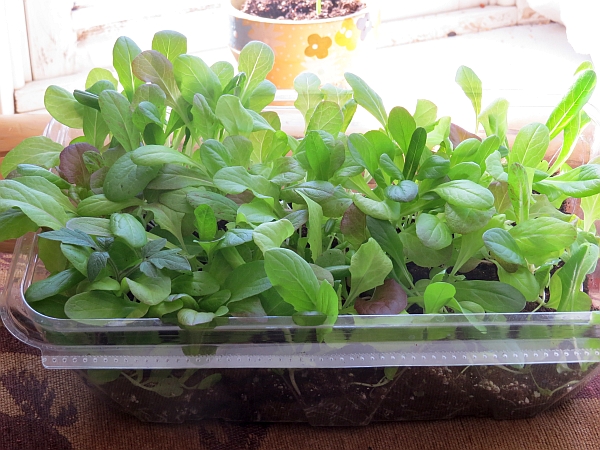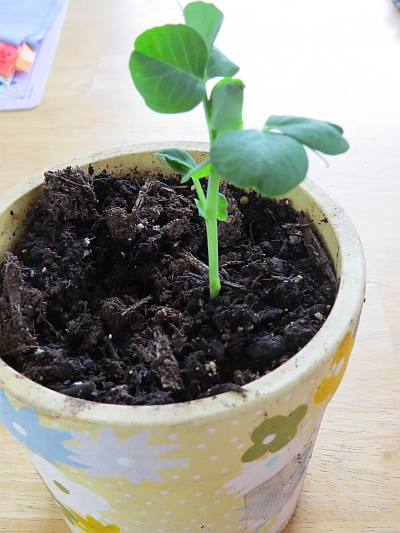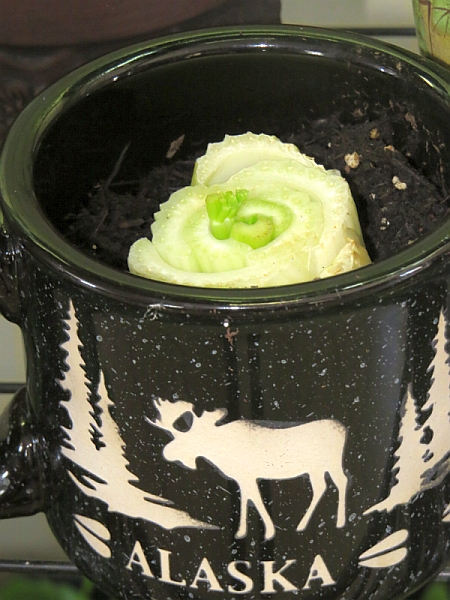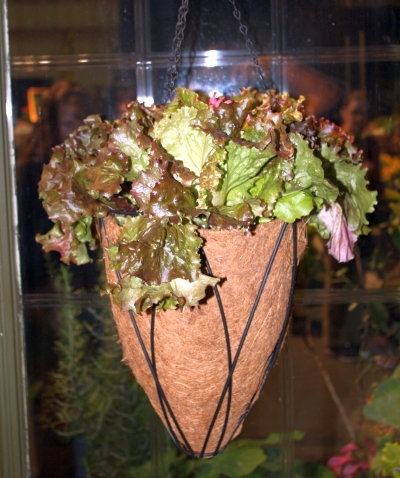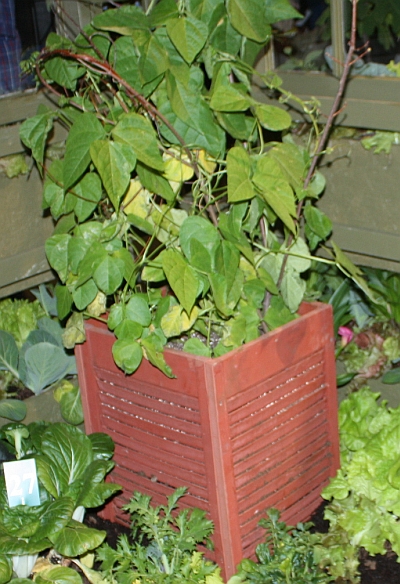Our food supply becomes a little less stable and more expensive each day because of drought and flooding, transportation costs and world issues. Everyone can grow at least a little bit of their own food. It’s simple to do, doesn’t cost a lot of money, takes little time, and can take up little space. Let’s get started.
Containers can be small clay pots, large wooden planters, plastic saved from your kitchen, and everything in between. Short term, we like to start with recycled containers. Any plastic container you can poke drainage holes in should work.
This is a container from mixed greens purchased in the grocery store. A few inches of seed starting medium mixed with a cup of worm castings is all it takes to support this cut-and-come-again salad mix. Notice the tomato seedling in the left corner? It will be transplanted into its own pot.
This is a Coral shell pea. It’s a small plant that with vines only two feet long, perfect for a six inch clay pot. It will stand up straight until it’s seven or eight inches tall then lean over and hang over the edge. Choose a short vine variety for small containers.
Do you have extra coffee mugs cluttering your cupboard? As long as you avoid over watering or can drill a hole through the bottom they make great containers. This mug holds store bought celery. It will develop roots and continue to grow.
Transplant seedlings into containers with the same guidelines as if you were planting them into the garden. Each plant must have enough room for its roots to spread. The container should be heavy enough with soil and plants to keep it from tipping over if you move it outside.
Look in your seed catalogs for a note or other indication marking varieties suitable for containers. It’s become such a popular way to grow vegetables now that many companies point these out to us. These are some of our favorites:
- Cucumber – Salad Bush, Space Master. Two plants per one gallon container. Look for words like Bush and Space in their name.
- Bush Beans – Tendercrop, Derby. Three plants per one gallon container.
- Tomatoes – Determinate varieties stop growing when they reach their maximum height. A five gallon container will hold one tomato plant. Super Bush is an excellent choice. It maxes out at three feet tall, is very frost hardy, and has three inch tomatoes. The stem is dense and keeps the plant upright with little or no staking. Tomatoes love the additional warmth containers offer.
- Peppers – Probably the least picky plants we’ve grown in containers. Provide a minimum of a two gallon container. Pepper plants have large roots when they have enough roots and might be more than four feet tall in good soil. Jalepeno and Ace bell varieties do very well.
- Swiss chard – Peppermint and Bright Lights are tasty and attractive. Two plants fit well in a one gallon container. You can choose a container that is wider than it is deep. Avoid over heating these cool weather plants.
- Tatsoi and Boc Choi do well in containers. Choose a “baby” variety of Boc Choi such as Purple or Shuko. You can combine tatsoi and boc choi together in one container to add a variety of color and make the container attractive. Avoid over heating.
- Cabbage – Little Jade or other Napa varieties do well in container gardens. Be sure to place them toward the back or in a partly shady area so their roots don’t over heat.
- Zucchini – who knew! Astia zucchini has performed well in an 18″ container every year for us. Hand pollinating is recommended for good production.
- Leaf Lettuce does well in containers. For variety, choose different colors and leaf textures. Leaf lettuce can be cut and left to grow again for another harvest. Salad Bowl, Red Sails, and Black Seeded Simpson do well with container gardening.
Container gardening outdoors requires some attention. Soil can dry out quickly in the heat and wind, or become flooded in heavy rain. Check them now and then to be sure roots haven’t grown out of or soil hasn’t blocked drainage holes.
Use a soilless mix or part soil mix for your containers. Avoid using 100% garden soil as it will compact over time, blocking good drainage and make it difficult for roots to spread. Your garden center will be able to show you what they offer and explain which brand might be best for your particular containers. It will contain vermiculite or perlite, and have a fertilizer such as composted cow manure in its mix. If you live in a hot and/or windy area you’ll want a mix with soil because it retains moisture better than soilless mixes.
Carrots are a great vegetable for kids. Seeds placed around the outer edge of the container will be able to be seen before they reach maturity and are pulled. Choose a container at least 12 inches deep, or grow a miniature variety.
You can avoid poor soil and space issues and still grow a lot of food by grouping containers together. Keep like plants together, such as tomatoes or peppers, to aid in pollination. Place containers wherever you have room. They don’t have all have to be together. Is there room for pots at the base of your mailbox? How about on your steps?
Do you have questions? Suggestions? Something to add? Comments are open!

